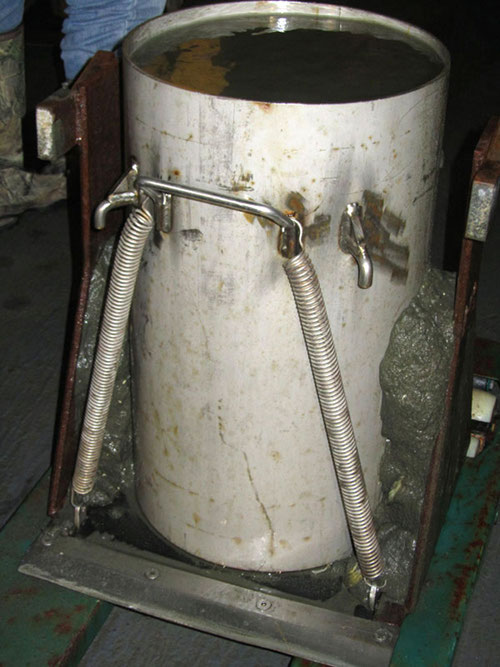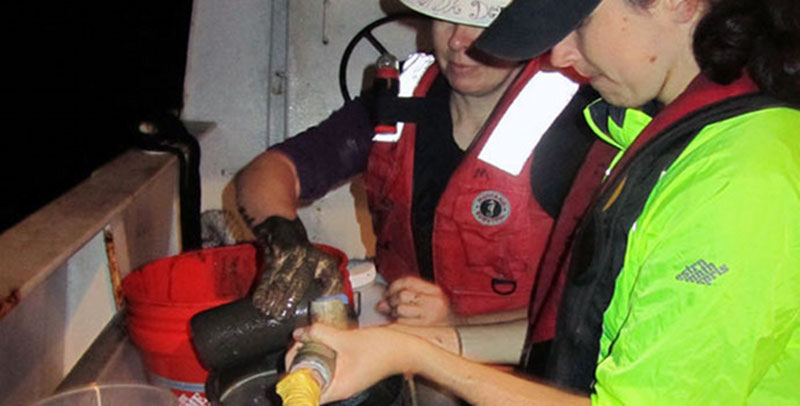
By Terry Connell, Web Coordinator - NOAA's National Ocean Service
September 20, 2012

The box core is lowered off the back deck of the NOAA Ship Nancy Foster using a winch. Image courtesy of Deepwater Canyons 2012 Expedition, NOAA-OER/BOEM. Download image (jpg, 60 KB).
Scientific gold, perhaps! I am sitting here in the "wet lab" of the NOAA Ship Nancy Foster. It is 8 AM on Thursday morning. We have been on this mission for three full days now and have barely begun the science because of the weather.
Box coring, data collection using the Conductivity-Temperature-Depth device, and multibeam scanning are the planned overnight research items during this expedition leg, with remotely operated vehicle (ROV) activities planned for daylight hours.
Last night, we pulled five of the eight planned box core samples before we had to stop. It was 2 o'clock in the morning when I stopped working on box cores with Amanda and headed to my berth to collapse. It is heavy, muddy work!
The process of core sampling is to use the ship's hoist to lower into the water a heavy metal contraption that drops quickly to the bottom of the ocean. Once it reaches the bottom, the metal core collector plunges into the ocean floor. Tension is measured in the cable at the winch and the operator can tell when the core has sunk as low as it will go and begins to retrieve it. Once it is being lifted, the tension values indicate whether sampling was successful.

A collected box core sample before it has been processed. Image courtesy of Deepwater Canyons 2012 Expedition, NOAA-OER/BOEM. Download image (jpg, 74 KB).
Once the box core is back on board, it is removed and placed on a heavy mechanics dolly. From this point, the collected sample goes through a several-step process that begins with draining off the top, crystal clear seawater. Then, smaller core samples are taken and silt is scraped off to a carefully measured 10 centimeters. That silt is processed through a screen which, to me, closely resembles sluicing for gold. But it isn't the metallic gold these scientists are looking for – it is the zoology that lives within that top layer of muck.
Scientists are taking core samples and studying life on the floor of Norfolk Canyon and comparing those data to the same depth samplings from nearby Baltimore Canyon.
Unfortunately, operations were halted last night and the sixth box core, which waited patiently on the rear deck under the hoist, never left the ship.

Scientists wash the collected box core sediment in a sieve to remove the fine particulate matter and leave behind larger materials. Image courtesy of Deepwater Canyons 2012 Expedition, NOAA-OER/BOEM. Download image (jpg, 61 KB).
When you need the ship to hold still for collection and ROV dives, you don't use an anchor, you use thrusters – very similar to space technology. This ship uses some pretty cool technology – Global Positioning System to lock the exact position the ship must stay in, which is tied to the thrusters that constantly adjust for action of the wind, waves, and current on this vessel, holding it steady at a single spot.
Sometime during the wee hours, the bow thruster quit. The ship was no longer able to hold its position and the core sampling operations were halted.
Since the multibeam scanner is not dependent on the thrusters, we finished off the night with mapping the seafloor. Now, the ROV team waits patiently for the bow thrusters to come back online so they can launch their vehicle. Such is research at sea...